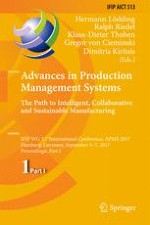The two-volume set IFIP AICT 513 and 514 constitutes the refereed proceedings of the International IFIP WG 5.7 Conference on Advances in Production Management Systems, APMS 2017, held in Hamburg, Germany, in September 2017.
The 121 revised full papers presented were carefully reviewed and selected from 163 submissions. They are organized in the following topical sections: smart manufacturing system characterization; product and asset life cycle management in smart factories of industry 4.0; cyber-physical (IIoT) technology deployments in smart manufacturing systems; multi-disciplinary collaboration in the development of smart product-service solutions; sustainable human integration in cyber-physical systems: the operator 4.0; intelligent diagnostics and maintenance solutions; operations planning, scheduling and control; supply chain design; production management in food supply chains; factory planning; industrial and other services; operations management in engineer-to-order manufacturing; gamification of complex systems design development; lean and green manufacturing; and eco-efficiency in manufacturing operations.
